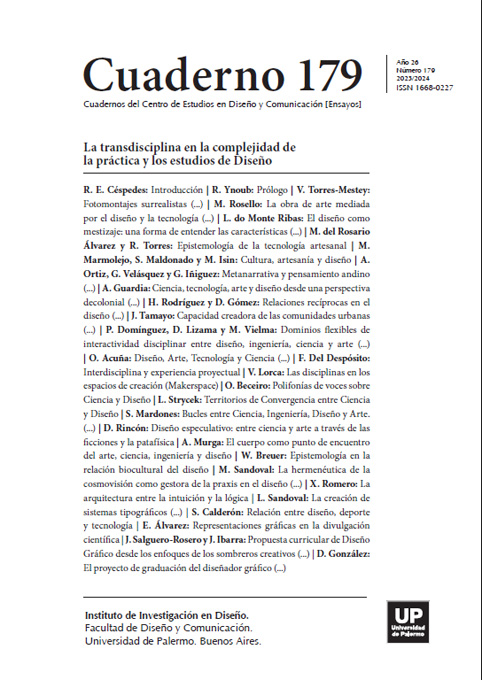Las disciplinas en los espacios de creación (Makerspace)
Palabras clave:
Makerspace ; disciplinas
Resumen
El diseño espacial y las herramientas son considerados fundamentales en la creación de espacios inclusivos y funcionales (Perner-Wilson et al. 2011)
Citas
Blikstein, P. (2013). Digital Fabrication and ’Making’ in Education: The Democratization of Invention. In J. Walter-Herrmann & C. Büching (Eds.), FabLabs.
Dougherty, D. (2013). The maker mindset. In Honey, M., & Kanter, D. (eds.). Design, Make, Play: Growing the Next Generation of STEM Innovators. NY: Routledge.
Gil, R. (2002). Neuropsicología. Masson.
Gold, R (2007) The Plenitude : Creativity, Innovation, and Making Stuff, MIT Press Greenfield, A (2013) Against the smart city : a pamphlet (Book)
Kelly, G (1955) Personal Construct Psychology.New York, Norton [©1955]
Kelly, A. (2013). Why do we need one of those? The role of the public library in creating and promoting Makerspaces. In ALIA National Library & Information Technicians’ Symposium, Canberra, Australia.
Manuel Esteban (2000) Adaptación de D. Jonassen, en C.H.Reigeluth (2000):El diseño de la instrucción. PDF.
Méndez, A. (2002). Constructivismo social.
Morin, E (1999) LA CABEZA BIEN PUESTA , Repensar la reforma, Reformar el pensamiento. Ediciones Nueva Visión Sale. Tucumán 3748, (1189) Buenos Aires, República Argentina.
Papert, S. (1980). Mindstorms—Children, Computers and Powerful Ideas. New York: Basic Books, Inc.
Perner-Wilson, H., Buechley, L. & Satomi, M. (2011). Handcrafting textile interfaces from a kit-of-no-parts. Proceedings of the 5th International Conference on Tangible Embedded and Embodied Interaction.
Piaget J (1969) Psicología y Pedagogía. Barcelona: Ariel.
Seymour Papert. (1988). The Conservation of Piaget: The Computer as Grist. Constructivism in the computer age (1988).
Vygotski L. S. (1924) El defecto y la compensación.
Vygotsky, L. S. (1989). El Desarrollo de los Procesos Psicológicos Superiores. Barcelona: Crítica. (Publicado originalmente en 1931)
Dougherty, D. (2013). The maker mindset. In Honey, M., & Kanter, D. (eds.). Design, Make, Play: Growing the Next Generation of STEM Innovators. NY: Routledge.
Gil, R. (2002). Neuropsicología. Masson.
Gold, R (2007) The Plenitude : Creativity, Innovation, and Making Stuff, MIT Press Greenfield, A (2013) Against the smart city : a pamphlet (Book)
Kelly, G (1955) Personal Construct Psychology.New York, Norton [©1955]
Kelly, A. (2013). Why do we need one of those? The role of the public library in creating and promoting Makerspaces. In ALIA National Library & Information Technicians’ Symposium, Canberra, Australia.
Manuel Esteban (2000) Adaptación de D. Jonassen, en C.H.Reigeluth (2000):El diseño de la instrucción. PDF.
Méndez, A. (2002). Constructivismo social.
Morin, E (1999) LA CABEZA BIEN PUESTA , Repensar la reforma, Reformar el pensamiento. Ediciones Nueva Visión Sale. Tucumán 3748, (1189) Buenos Aires, República Argentina.
Papert, S. (1980). Mindstorms—Children, Computers and Powerful Ideas. New York: Basic Books, Inc.
Perner-Wilson, H., Buechley, L. & Satomi, M. (2011). Handcrafting textile interfaces from a kit-of-no-parts. Proceedings of the 5th International Conference on Tangible Embedded and Embodied Interaction.
Piaget J (1969) Psicología y Pedagogía. Barcelona: Ariel.
Seymour Papert. (1988). The Conservation of Piaget: The Computer as Grist. Constructivism in the computer age (1988).
Vygotski L. S. (1924) El defecto y la compensación.
Vygotsky, L. S. (1989). El Desarrollo de los Procesos Psicológicos Superiores. Barcelona: Crítica. (Publicado originalmente en 1931)
Publicado
2023-02-27
Cómo citar
Lorca, V. (2023). Las disciplinas en los espacios de creación (Makerspace). Cuadernos Del Centro De Estudios De Diseño Y Comunicación, (179). https://doi.org/10.18682/cdc.vi179.8879
Sección
Artículos
Los autores/as que publiquen en esta revista ceden los derechos de autor y de publicación a "Cuadernos del Centro de Estudios de Diseño y Comunicación", Aceptando el registro de su trabajo bajo una licencia de atribución de Creative Commons, que permite a terceros utilizar lo publicado siempre que de el crédito pertinente a los autores y a esta revista.


